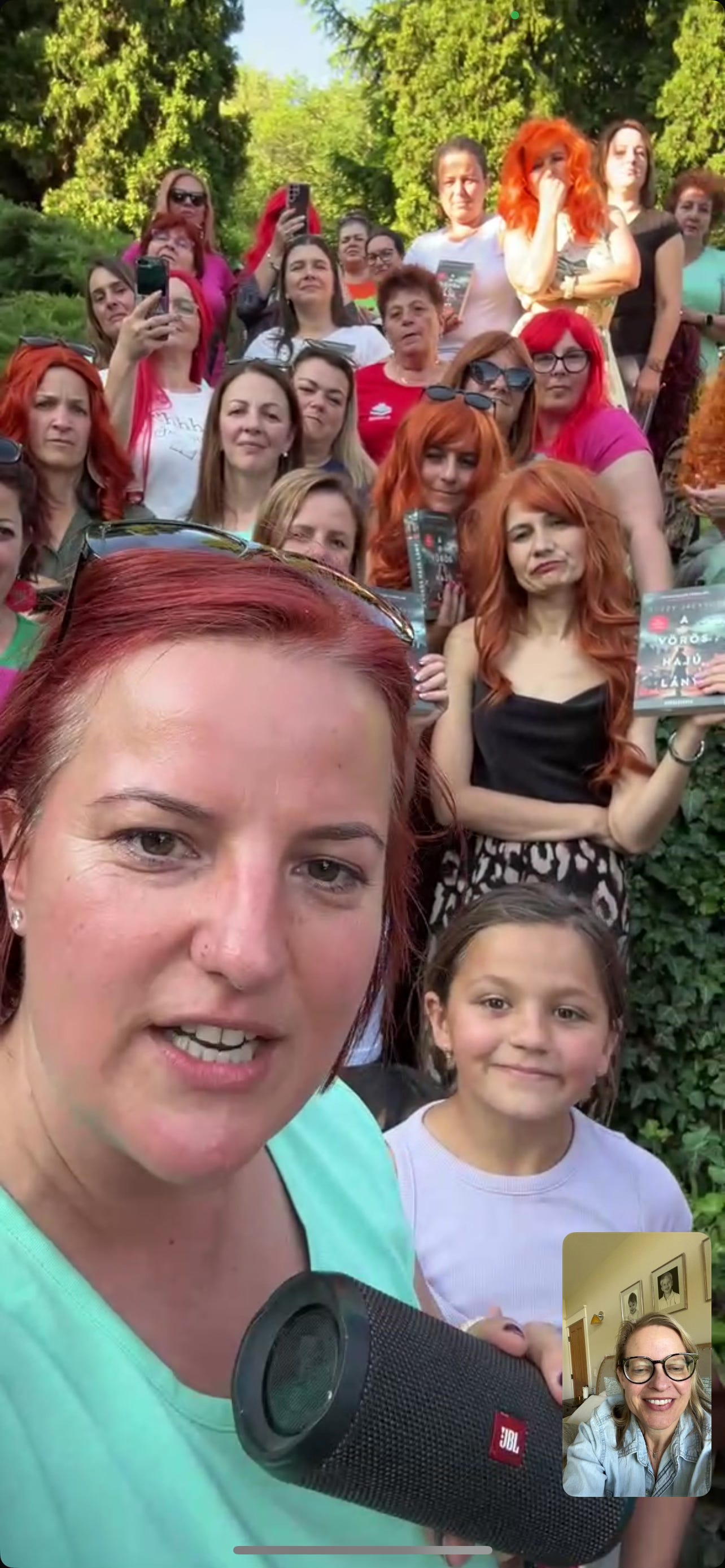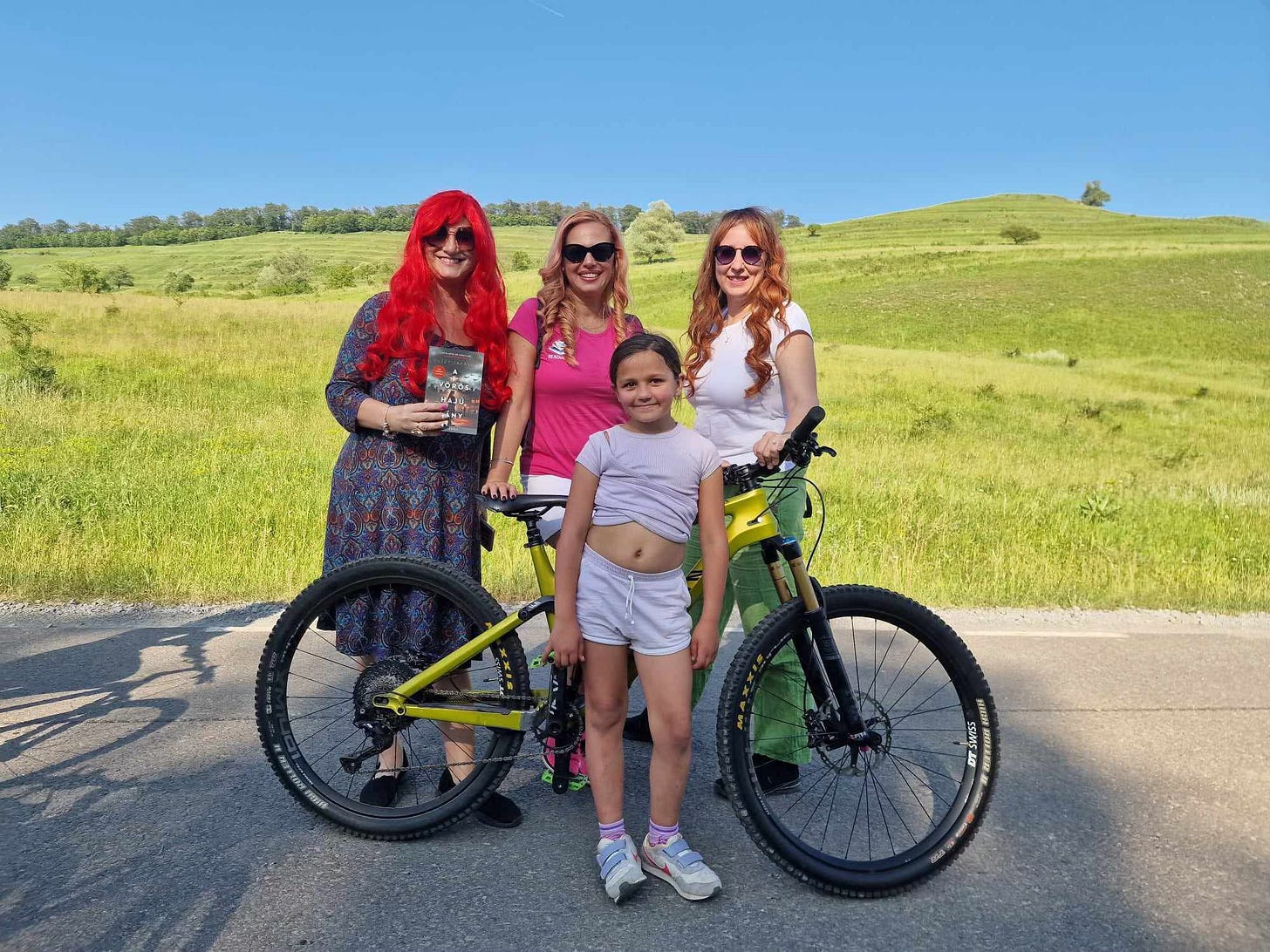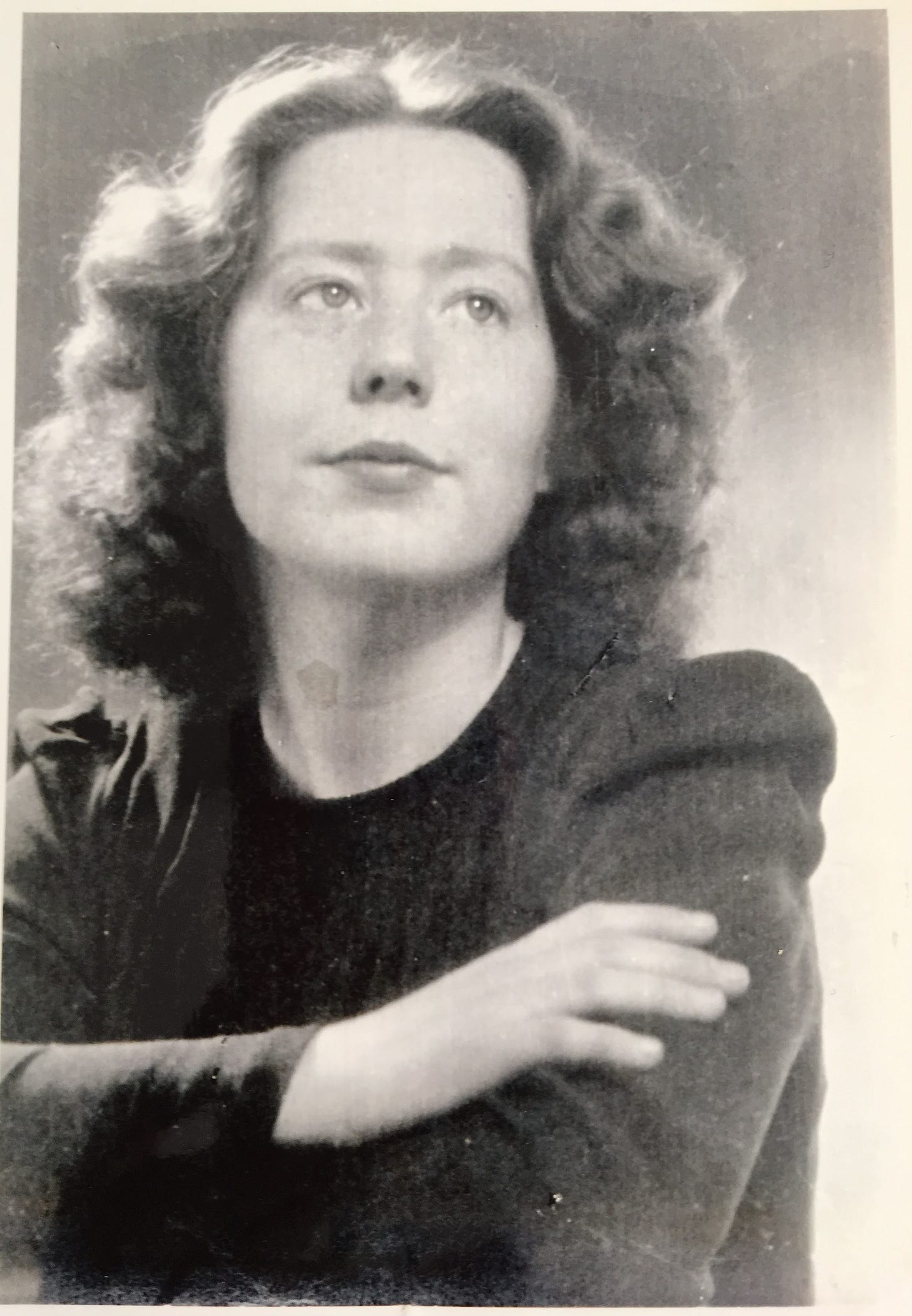The Long Ride of Hannie Schaft
Why Hannie Schaft's story of resistance still moves readers—on two wheels, in red wigs, across the world... all the way to Transylvania
Dear CSTers,
Two years ago, I published a historical novel called To Die Beautiful (in the USA) or The Girl with the Red Hair (in international editions)—a novelized retelling of the real lives of Hannie Schaft, Truus (Menger) Oversteegen, and her sister Freddie, college-age Dutch resistance fighters who risked their own lives to protect their Jewish friends and oppose the Nazi occupation of the Netherlands. Their story had long been marginalized or mythologized, reduced to a few wartime photographs and one memorable detail: the color of Hannie’s red hair.
When I first came across their story in the winter of 2016 I was in Amsterdam on a family vacation. I’d never heard of these young women before. But I couldn’t stop thinking about them. It was Christmastime and the UK had just voted to exit the post-WWII peace-building project known as the European Union, while in my own country Donald Trump had recently been elected President with a promise to target immigrants and jail his political opponents. The three young Dutchwomen’s bravery felt urgent, personal, and real.
I remember walking along Amsterdam’s canals that day thinking: why hasn’t someone already written a book about these extraordinary Resistance fighters? Well, I’m a historian by training. So I decided to try.
As writers, living with uncertainty is part of the job. We write through rejection, edits, reviews, and marketing cycles. I spent eight years researching and writing To Die Beautiful/The Girl with the Red Hair without knowing if it would ever be published, much less translated into nine languages. Every author hopes their book will connect with someone, somewhere. But what I never imagined—what has truly stunned and moved me—is what’s happened since the novel came out in 2023.
Like resistance work itself, it turns out this is a book that travels by word of mouth, by book club, by daughter to mother, or teacher to student. I’ve come to believe in the long tail: the idea that some stories bloom gradually, not all at once. They echo, they travel, they ride.
And Hannie’s story, in particular, seems to be striking a nerve right now. In the months since Trump’s reelection last November, barely a week has gone by when I haven’t been contacted by a book club or organization interested in learning more about Hannie Schaft’s true story of resistance. Just last week in Colorado, where I live, I met a Brazilian tourist who heard my name and lit up: she had a copy of The Girl with the Red Hair on her shelf at home, in Portuguese.
As fascism rises around the world today, the story of young women who risked everything to stand up to authoritarianism, racism, and violence feels newly urgent. But it’s also a story that is also deeply hopeful. Hannie’s resistance wasn’t a pose. It was thoughtful, brave, and rooted in principle. And that’s what readers keep telling me they feel when they read her story: a sense of possibility. Of clarity. Of connection.
I think this is partly because Hannie's story is more than historical. It speaks to a need many of us feel, especially today. At every protest I attend these days, I feel a growing, desperate desire by people everywhere to be brave, to do something that matters, and to honor the complexity of resistance. Hannie’s is not a story of invincibility. It’s a story of personal conviction and moral courage.
I’ve now met with around 100 book clubs around the world, in person and through video calls. I’ve heard from readers in The Hague, Berlin, the UK, Barcelona, and Berlin. The Spanish voice actor who read the audiobook version sent me a video message of herself breaking down in tears while reading the book aloud. The Brazilian translator contacted me to thank me for sharing Hannie’s story ; as a woman who lived through oppressive political regimes in her own country, she told me she felt personally connected to and inspired by these Dutch women freedom fighters. Just as I’d hoped when I first started writing. As writers, we rarely get to witness the ripple effects of our work in such emotional and personal ways.
And then, a few weeks ago, I got an email from a book club in Transylvania.
“’I’m writing to you from Transylvania, Romania,” Dolly, one of the group’s leaders, wrote, “and this month we are reading your powerful book A vörös hajú lány (To Die Beautiful). Our group has 41 members, and your book has deeply moved and inspired us. The story of Hannie Schaft sparked heartfelt conversations and emotional reflections in our meetings. For our upcoming discussion, we are planning something special: we will arrive at the venue by bicycle and with red hair – in tribute to Hannie. We want to honor her spirit and courage in a way that brings us closer to her story.”
I was, of course, amazed and delighted, and I offered to call into the meeting in person to answer questions. And that’s how I ended up on a WhatsApp video call last week. Their leader had kept my call a secret; they’d made this ride for Hannie. The women dressed up in red wigs, carried fake pistols, and biked five miles through the Romanian countryside to a small village to honor her.
As the leader turned her phone toward the group, I saw forty women and girls screaming with surprise—and then crying, and waving, and beaming with this contagious, electric energy. I cried, too. The Romanian “Hannies” waved their books in the air and cheered, and international time zones, continents, and language barriers disappeared. Somehow, a single story had become an event, a movement, a shared memory.
“God bless you for writing such a beautiful and painful book,” said one of the readers, and the group of forty women and girls cheered. They were moved by the same things I had been struck by nine years ago: the three heroines’ courage, love, resistance, and a fierce kind of hope. Hannie, Truus, and Freddie weren’t symbols. They were real young women willing to sacrifice everything for a better, more just and peaceful future.
I had always hoped their story would resonate—but I’m still astonished by just how deeply it has. To me, the joy of that Transylvanian bike ride wasn’t just that these women had read my book—it was that they saw themselves in it. They wanted to embody the spirit of Hannie, to laugh and ride and remember together.
I did not write this book expecting Transylvanian bike rides in tribute to Hannie Schaft. But the red-wigged women of Romania, the emotional readers of Spain, Brazil, Germany, and elsewhere, showed me that sometimes, when the world needs it, a story finds a second life. Or maybe it never dies at all. My goal in writing the story of Hannie Schaft and Truus and Freddie Oversteegen was simple: I believed their story was too important and inspiring to remain untold. The response I’ve gotten from these wonderful readers around the world has brought me renewed hope in my Resistance work in my own country, the United States, and for freedom fighters everywhere.
In her memoir, Not Now, Not Then, Not Ever, Truus Oversteegen tells a story about preparing for a resistance operation. It’s 1944 and Truus is waiting impatiently for Hannie to get ready for a dangerous assignment (they paired up to assassinate Nazis and their Dutch collaborators). “We’re going to be late,” says an annoyed Truus, to which Hannie replies, lipstick in hand: “Truus, if I’m going to die, I’m going to die beautiful.”
I believe Hannie did. And I believe she would have wanted her story not to fade into the past, but to live in the present—in women who ride bikes, in people who read, in anyone who feels the call to be brave. So to you beautiful, radiant crew of Romanian readers: Thank you. You reminded me that stories don’t just stay on the page. They get up. They move. They ride.
Long live Truus and Freddie Oversteegen. And long live Hannie Schaft.
xo Buzzy










Thanks for giving me a selection for my new book group - in Portland, Oregon after 40 years in Boulder. I'm here to be near my daughter. It's so difficult to see what young people are going through, daily, with the news and with their own attempts to protest and make change.
On another note, a nice thing you did:
During the pandemic, I discovered Rose had the beginnings of a novel and I suggested we take your one-night workshop on writing a pitch. Turns out, she was also thinking of writing a book about some aspect of punk music history and asked a question about interviewing. You gave a thoughtful and supportive answer.
For now, she's making the music but will return to the writing at some point.
Her band, Love in Hell, is bringing flowers to punk. I love The Empress, female empowerment in a way: https://loveinhell.bandcamp.com/album/demo-2